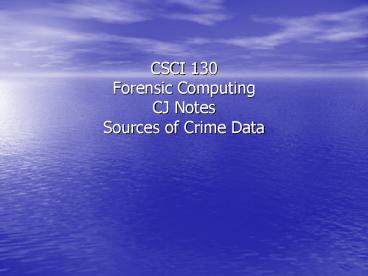CSCI 130 Forensic Computing CJ Notes Sources of Crime Data - PowerPoint PPT Presentation
1 / 5
Title:
CSCI 130 Forensic Computing CJ Notes Sources of Crime Data
Description:
CSCI 130 Forensic Computing CJ Notes Sources of Crime Data I. Uniform Crime Reports a. Official crime data b. Obtained via crimes reported to police c. FBI is ... – PowerPoint PPT presentation
Number of Views:86
Avg rating:3.0/5.0
Title: CSCI 130 Forensic Computing CJ Notes Sources of Crime Data
1
CSCI 130Forensic ComputingCJ NotesSources of
Crime Data
2
- I. Uniform Crime Reports
- a. Official crime data
- b. Obtained via crimes reported to police
- c. FBI is national repository for crime
responsible for collecting and disseminating
reports - d. Collects incidence data
- e. Limitations
- 1. not all crime reported to police
- 2. agencies may be bias data in how they
classify offenses - 3. Part II offenses only report arrests
3
- II. National Criminal Victimization Survey (NCVS)
- a. Begun in 1973 as NCS
- b. Bureau of Census survey sample of citizens
as to their victimization experiences over the
past six months - c. Measures victimizations of persons in
household 12 yoa and older - d. Asks if offence reported to police if not,
why not - e. Limitations
- 1. does not measure crimes where victim lt12
yoa - 2. does not measure homicides
- 3. does not measure commercial house
robberies bank robberies - 4. does not measure burglaries
4
- III. Self-Reports
- a. Ask persons about their criminality or
deviance - b. Offender directed
- c. Surveys of juveniles in schools detentions
houses inmates citizens at large - d. May be biased as respondents over- estimate
or under estimate activity - e. Ethnographies are a type of self-report
anthropology heritage
5
- f. Use of informants to gain first-hand
knowledge of behavior lifestyle (early heroin
user/addict research) - g. Snowball technique, where investigator is
introduced to an addict, who in turn introduces
the investigator to another and so on - h. Allows investigators to study/learn about
offenders in ways not possible with UCR or NCVS































